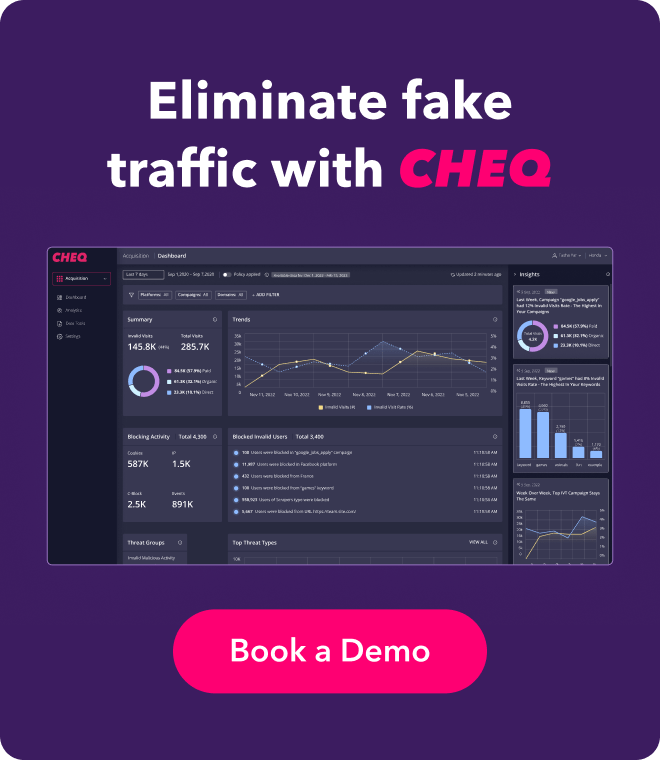How to Address ‘Bad Leads’ In Your Funnel
Jeffrey Edwards
|Cyber Risks & Threats | July 25, 2023

In a perfect world, every lead that enters your sales funnel would turn into a paying customer. But we all know that’s far from reality. Every business grapples with its fair share of ‘bad leads’ and ‘fake leads,’ both of which can drain resources and skew critical metrics. This article will explore the difference between bad and fake leads and offer effective strategies to overcome these challenges.
Understanding Your Problem: Bad Leads vs. Fake Leads
For marketers navigating the complex terrain of lead generation, one of the key challenges is differentiating between ‘bad leads’ and ‘fake leads.’ Both types may exist within your sales funnel, but they present distinct problems and demand unique solutions. Misunderstanding or conflating these two types can lead to wasted resources, skewed marketing data, and ineffective sales strategies. Addressing a ‘bad lead’ as if it were a ‘fake lead’ or vice versa could derail your marketing efforts and lead to a misallocation of resources.
Bad Leads
A ‘bad lead’ is a legitimate potential customer who, for various reasons, is unlikely to convert or buy a product or service. They might not fit your ideal customer profile due to demographic, psychographic, or behavioral discrepancies. For instance, a teenager who stumbles upon your high-end business software website might technically be a lead but qualifies as a ‘bad lead’ because they’re not the target audience and unlikely to convert.
The primary challenge with bad leads is the potential drain on resources. Time and effort spent nurturing these leads are likely to yield little return. Moreover, a high volume of bad leads can distort your understanding of campaign performance, leading to misguided marketing decisions.
A Word on ‘Fluffy’ Leads
Often in lead generation conversations, the term ‘fluffy leads’ comes up. These are typically leads coming from top-of-funnel content that may download an informational asset and then take no further steps toward conversion. It can be tempting to lump such leads in with the bad leads and call it a day, but unlike ‘bad leads,’ who are unlikely to ever convert, ‘fluffy’ leads might just need more time and nurturing. They could be in the early stages of their buying journey, still researching and comparing options. While they may not contribute to immediate sales, they hold potential value for the future.
Fake Leads
While bad leads are a pain–and a sign of a poorly optimized marketing program–fake leads represent a more pernicious problem. These are not real potential customers at all. They could be bots programmed to mimic human activity or fraudulent actors intent on breaching your system’s security. An example might be a bot that fills out your website forms, mimicking lead generation but with no intention or capability to purchase.
Fake leads can distort your marketing metrics, making campaigns seem more successful than they are. This false data can misguide your marketing strategies, leading to wasted spending and misdirected efforts. But more worryingly, these fake leads can pose security threats. If fraudulent actors are at play, they might be seeking to steal sensitive information or exploit system vulnerabilities. The challenges posed by fake leads can thus be potentially more damaging than those posed by bad leads. Properly distinguishing and addressing these concerns is therefore crucial for a business’s success and security.
How to Address Bad Leads in Your Funnel
Now that we know the difference, let’s look at a few techniques and best practices that will help keep bad and fake leads out of your sales funnel.
Implement More Precise Targeting and Messaging
Casting a wide net with your marketing might seem like a good idea initially; however, it often leads to an influx of bad leads. Therefore, a strategy based on precise targeting is imperative. This goes beyond just PPC campaigns, advertisements, and social media—it extends to your SEO and content strategies.
To illustrate, a business selling advanced digital art software might be inclined to use broad, 101-level content like ‘Introduction to Digital Art’ to reach as many people as possible. While such content can generate considerable traffic, it’s likely to attract a lot of people who have a casual interest in digital art, many of whom might not be ready to invest in an advanced, premium tool.
A more effective strategy would involve creating more niche, in-depth content, such as ‘Advanced Brush Techniques for Digital Portraits’ or ‘Using Layer Masks in Digital Art.’ This type of content is more likely to attract serious digital artists who might be interested in purchasing sophisticated software.
In terms of targeting for advertisements and PPC campaigns, it’s crucial to take into account your audience’s demographics, interests, and behaviors. For example, using our digital art software company, you could target your Google Ads campaign towards individuals who are searching for terms like “professional digital art techniques” or “advanced digital painting tools”. In social media advertising, you could target users who follow digital art influencers, or who are part of digital art groups.
For SEO, target keywords that your ideal customer would search for, such as “digital art software for professionals” or “advanced digital painting tools.” This way, when potential customers are searching for these keywords, your business is more likely to show up in their search results.
Refine Your Lead Qualification Process:
Even among real leads, not all leads are created equal. Some will have a high propensity to convert, while others, despite initial interest, might not be a good fit for your product or service. The process of sifting through these leads to identify the potential winners is called lead qualification.
The art of lead qualification often relies on firmographic data, similar to demographics but for organizations. A firm’s industry, size, location, and revenue can provide significant clues about its potential needs. For instance, if your product is an advanced CRM software, larger companies with hundreds of employees might be better leads than a small local business.
Another popular lead qualification technique is the BANT framework—Budget, Authority, Need, and Timing. It’s a simple yet effective method for determining whether a lead is worth pursuing. For example, does the lead have the Budget for your product? Do they have the Authority to make purchasing decisions? Do they have a Need for your solution? And is the Timing right for them to make a purchase?
Refining your lead qualification process with firmographic data and BANT can help you differentiate between bad and potentially successful leads, ensuring your sales team spends their time wisely, and that your marketing team is able to make informed decisions to adjust targeting and messaging in further campaigns.
Nurture Your Leads
Lead nurturing is an integral part of the sales process, particularly when dealing with ‘fluffy’ leads. The idea behind lead nurturing is to provide these leads with relevant, valuable information that helps them progress down the sales funnel.
An effective lead nurturing process involves consistent, personalized communication tailored to the lead’s interests and stage in the buyer’s journey. This can take the form of email marketing, targeted content, social media interaction, or even personal outreach.
Consider this example of a lead nurturing path for a company selling a project management software:
Initial Engagement: The lead downloads an e-book from your website titled “How to Improve Project Efficiency.” This act suggests interest in project management improvement.
Follow-Up Communication: A few days later, send an email thanking them for their download and offering a blog post that dives deeper into the topic, such as “5 Tools for More Efficient Project Management.”
Educational Content: Once they’ve engaged with the blog post, you can send a series of emails over the following weeks providing more in-depth information on project management efficiency. This could include case studies demonstrating how your software has improved efficiency for other companies, webinars explaining the use of your product, or whitepapers on industry trends.
Product Specific Information: As they engage more, introduce content specific to your product: a video demo of your software, customer testimonials, or a detailed product guide.
Closing the Deal: Finally, after you’ve provided ample information and value, it may be time to make a direct offer. This could be a free trial, a product discount, or a consultation with a sales rep.
Addressing Fake Leads
Now that we’ve addressed how to handle bad leads, it’s essential to recognize another, potentially more damaging issue: fake leads. Let’s explore how to prevent these fraudulent entities from skewing your data and draining your resources.
Implement CAPTCHA Challenges
A CAPTCHA–which stands for Completely Automated Public Turing test to tell Computers and Humans Apart–is a security measure used on websites to prevent automated bots from carrying out specific actions. These actions could include submitting forms, making a purchase, or creating an account.
Google’s ReCAPTCHA is an evolution of this concept that uses a risk analysis engine and adaptive CAPTCHAs to analyze the behavior of each visitor to your site and determine whether it’s a bot or a human. For instance, users might be presented with a simple checkbox stating “I’m not a robot” or asked to identify objects within a series of images.
This service is free, easy to set up, and requires minimal maintenance, making it a cost-effective tool to help reduce the number of simple bots and bad leads entering your funnel.
However, such tools aren’t without their drawbacks, particularly when it comes to the impact on user experience. A user being asked to identify grainy images of traffic lights, fire hydrants, or bicycles or decipher distorted text might find the process tedious and annoying. This issue is especially pronounced for mobile users, who often find interacting with CAPTCHAs challenging due to the small screen size. As a result, there can be a high rate of false positives, wherein genuine users are incorrectly identified as bots, and page abandonment, as users get frustrated and leave your site.
Related: How Fraudsters Use Bots to Bypass CAPTCHA Challenges
Additionally, while ReCAPTCHA serves as a hurdle for many bots, it is not impervious to all. Advanced AI can now solve CAPTCHA puzzles, and even more sophisticated bots might connect the challenge to a captcha-solving service. In such a setup, a real human, possibly working in a click farm, solves the CAPTCHA on behalf of the bot, thus bypassing the test meant to distinguish humans from bots.
So, while ReCAPTCHA can be an effective part of your arsenal against fake leads, it’s crucial to balance its use with the potential impact on user experience and its limitations against advanced bots and bot networks. Relying solely on ReCAPTCHA is unlikely to be enough.
Consider a Double Opt-In
A double opt-in process, or email verification process, is another method used to differentiate between real users and automated bots. With this process, when a user fills out a form providing their email address, they will receive a confirmation email containing a link. They need to click on this link to confirm their email address is correct, and that they wish to proceed. This two-step process can be an effective way to deter bots, as they’re unable to access the email account and click the link to complete the form submission.
While the double opt-in offers a high level of protection against bots, it also comes with its own set of challenges, particularly in terms of user experience. The requirement for the user to take an additional step — checking their email and clicking on the verification link — introduces a point of friction in the process. It requires the user to leave the site, possibly navigate to a different device to access their email, and then return to your site after clicking the verification link.
Related: Form Bots 101: Protecting Your Business From Spammy Leads and Traffic Burden
As a result, there’s a risk that many users will abandon the process at this stage. They might get distracted, decide the extra step is too much hassle, or simply forget to come back and complete the verification. Each of these scenarios means a lost lead for your business, even though the individual had initially shown interest.
So while double opt-in or email verification can be a useful tool in the fight against fake leads, it’s recommended that it is used judiciously. Consider employing this method for more sensitive processes where the added layer of security is necessary, such as during account creation or password resets. This way, you can strike a balance between ensuring the security of your users’ data and offering a smooth, frictionless user experience that encourages genuine leads to engage with your site.
Consider Adding Bot Traps
Honeypots and bot traps are stealthy security measures specifically designed to attract, detect, and thwart automated bots.
The honeypot technique exploits the key difference between human users and bots: their interaction with a webpage. A honeypot field is a form field that’s hidden from human users but visible to bots. To a bot, this field looks like any other input field and it fills it in, not knowing it’s a trap. Human users, however, won’t see this field and therefore won’t fill it in. If a form submission includes data in the honeypot field, it’s a clear indication that the form was completed by a bot and the submission can be flagged or discarded.
To hide honeypot fields from human users, you might use CSS to make the field the same color as the background or position it off-screen. Keep in mind, some advanced bots can detect honeypots, so this method should be used as one part of a layered security approach.
Similar to honeypots, bot traps are designed to catch bots in the act. Instead of hiding an element, bot traps often involve a challenge that a human would pass with ease, but a bot would fail. This could be a simple mathematical problem or a logical question. The bot trap could also be a field that needs to be left blank (the opposite of a honeypot). Bots, following their programmed behavior, will fill in all fields, thus falling into the trap.
Explore Rate Limiting
Rate limiting is a defensive measure used by many websites and applications to protect their resources and ensure service availability to all users. It’s a technique that limits the number of requests a user, or more specifically, an IP address, can make to a service within a certain timeframe. The goal here is to prevent any single user (or bot) from overwhelming the system with a flood of requests, which could potentially cause a denial of service for other users, degrade performance, or allow for web scraping and other automated malicious activities.
At a technical level, rate limiting is implemented on the server side. For example, by using middleware for your application or server, such as express-rate-limit for Node.js or Django Ratelimit for Python. When a request comes in, the middleware checks the IP address of the request against a database that keeps track of the number of requests made from each IP address within a set period of time.
If the request exceeds the limit set, the middleware will block further requests from that IP address until the rate limit reset time has passed. This is communicated back to the client (or the bot) by sending an HTTP 429 “Too Many Requests” response.
To illustrate, you could set a rate limit rule that allows one IP address to submit 10 forms per hour. This would be an effective measure against a bot attempting to flood your site with form submissions, as after the 10th submission, the bot would be blocked until the rate limit resets.
However, rate limiting does require careful planning. It’s crucial to set appropriate rate limits that prevent bot activities without hindering legitimate users’ experience. If the rate limits are too strict, it may inadvertently block genuine users who are just more active. Hence, you should consider whitelisting certain IP addresses that are known to belong to legitimate users, such as your own company’s IP addresses, so they are unaffected by the rate limit rules.
Bear in mind that while rate limiting is a powerful tool, it is not a panacea. Sophisticated bots can rotate IP addresses to bypass rate-limiting measures, hence it’s often used in conjunction with other techniques like CAPTCHA or bot traps to offer a more comprehensive defense against fake leads.
Rate limiting ultimately offers you more control over how your service or website is used, allowing you to block, limit, or define better quality interactions, ensuring that your service remains available and reliable for genuine users.
Protect Your Funnel with CHEQ Sign-Up & Lead Protection (SLP)
While the strategies we’ve outlined in this article can help tackle the issue of fake leads, they are often time-consuming, result in increased friction for users, and may still allow advanced threats to slip through. Furthermore, they could end up putting more strain on your IT department. The best solution to mitigate these issues is to leverage a comprehensive fraud and bot detection tool.
CHEQ Sign-up & Lead Protection (SLP) is designed specifically to protect against fraudulent and automated activities that lead to fake leads infiltrating your funnel. As part of the CHEQ On-Site Security solution, SLP applies a series of sophisticated cybersecurity challenges to each user as they land on your site, and continues this rigorous validation process right up to the moment a form is submitted.
In real-time, CHEQ SLP evaluates behavioral patterns and data inputs like email and phone number for authenticity. In instances where a form submission is deemed invalid, it can either be removed from your funnel or marked with detailed detection data, a risk score, the identified threat type, and a recommended action.
By integrating CHEQ SLP into your lead generation process, you can ensure that your time, resources, and advertising budget are dedicated to nurturing genuine leads, improving your conversion rates, and, ultimately, driving business growth. Secure your lead generation process with CHEQ SLP, and take a significant step toward eliminating fake leads from your sales funnel.












